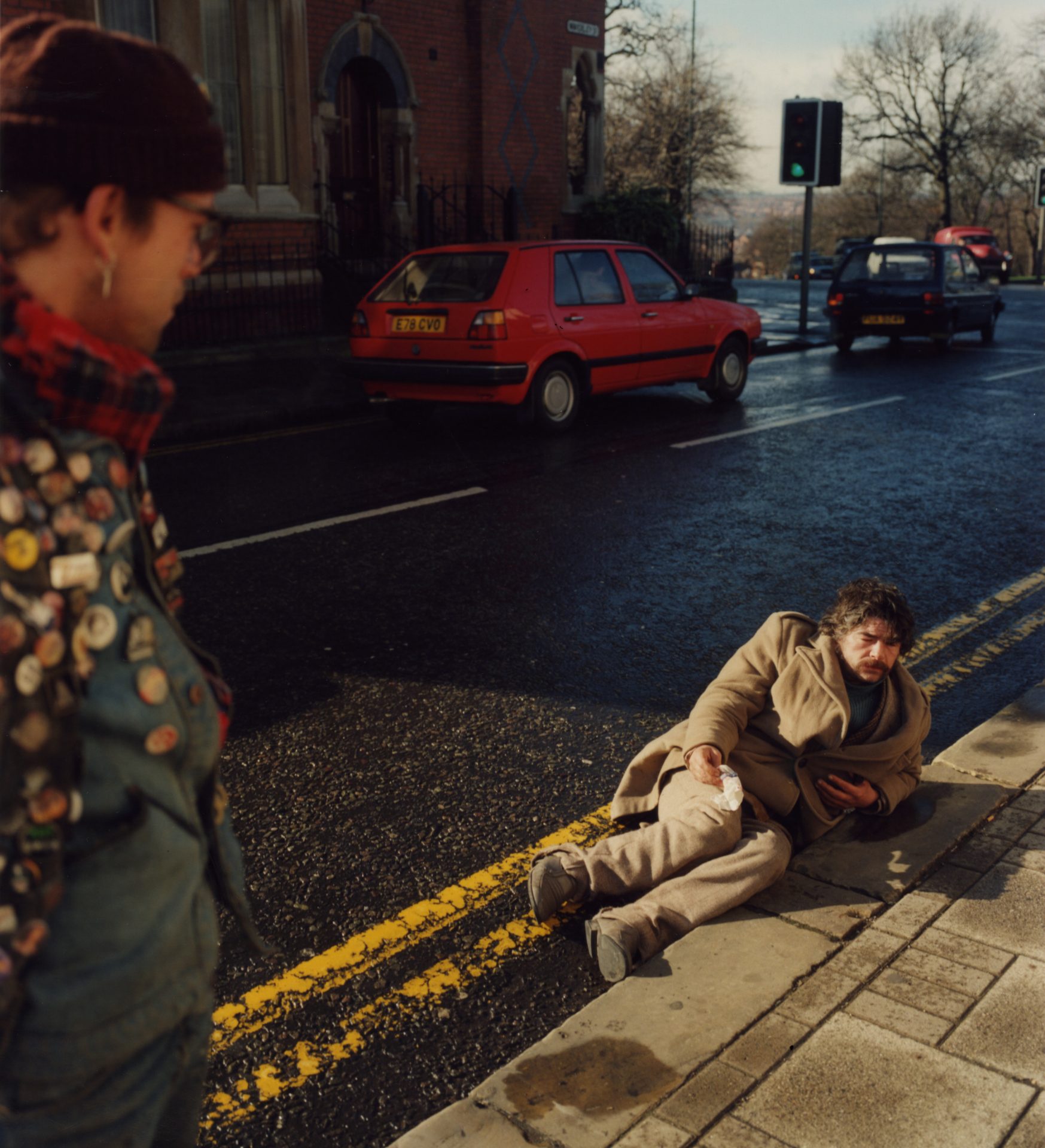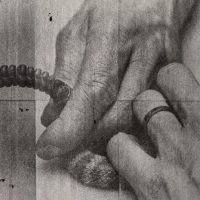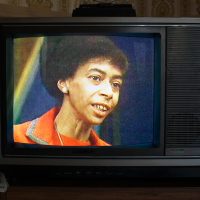Eva Maria Ocherbauer is an Austrian artist working between Berlin and Lagos, Nigeria.
Episode 56: I had the absolute pleasure of speaking with Eva Maria Ocherbauer about her life and work. Perhaps more fortunate than this conversation for me is that I also have the pleasure of knowing Eva personally after meeting her in 2017 in Berlin during a workshop with John Gossage. Those two have been friends for a very long time and I can see why. Eva is a free spirit whose wanderings in and around photography exemplify the best of what I think of when I think of an open-minded and creative personality. This type of creator is often led to new territory or terrain and Eva’s work has led her many places-a free spirit if you will.

Andreas Brandolini as Brumbi Wundschock, Berlin – 1986
Eva’s work is varied. We spoke about her early work that she made in Berlin when she moved there from her native hometown of Graz, Austria-the home of Camera Austria, Arnold Schwarzenegger (had to) and Seiichi Furuya. She also makes work abroad in Africa which we also covered. Eva has humored me on several occasions about her Berlin work from the 80s; a period that I am fascinated by. She was there to see the wall. She was there to make photographs of Blixa Bargeld and Einstürzende Neubauten and she was there when Gossage was making his Berlin work. She adds another layer to my imagined and enforced nostalgia about the era and has been kind enough to speak with me about the works several times including a written interview on American Suburb X that I am attaching below.

Blixa Bargeld’s room, 1984
In the interview, we speak on her practice, the nascent period of making images that would become her book Berlin West and how she views making complex images in Africa where she is also one of the founders of Fotofactory Lagos which offers young Nigerian photographers a platform for development. Her work is full of life and full of curiousity-a trait that I full adore. I hope you have a moment to listen.

Addis Ababa 2011 / THE PARK, Tiergarten Berlin
Interview from American Suburb X
July 1, 2018
I am fascinated by Berlin in several ways as it plays into the representation of the culture at large, but specifically in the images that were produced during a particular atmosphere and era-the effects of the cold war, the division of the city under occupation. It’s easy when I look from my own perspective of an American who grew up in a very different climate to force nostalgia on the production of images that were made. I am still mining why I am interested in the whole of it. A large part of it comes from the cold nature of many of the bodies of work produced there by different authors, some such as John Gossage, an American who saw the city with a different set of eyes, but also with fascination is also considered along with the images by Michael Schmidt, Michael Ruetz, Raymond Depardon, Andre Gelpke and a host of others. I try not to force nostalgia on it or focus simply on the darker turns that the post-war economy of images that accompanies it. And Yet, I cannot escape the German Experiment of either half of the Twentieth Century.
Eva Maria Ocherbauer is first off, not German. She is Austrian, but she moved to Berlin in the early 80s at a time when the anxiety of the political system and the youngest generations of the cold war were fomenting a despair that ultimately would turn towards creativity instead of ruin. Between music, theater, painting, and photography, creativity thrived under adverse conditions. To be in Berlin for this changing time before the fall of the wall, when the pressure cooker of systems were at a zenith must have been truly difficult and yet truly unique and exhilarating. Eva answered some of my questions about a certain time and place and her actions within it. Again, its hard not to bring in a false nostalgia when considering an era and place of influence not one’s own, so though I am partial, I think Eva was able to successfully broadcast the plausible scenarios with me. Thank you, dear Eva.
BF: Your work “Berlin West” has a good many of attributes that I adore. More specifically, when looking at the book and supplementary images from the time, I am reminded that not all was cold, but certainly that all was particular to the conditions that I have outlined. You came to Berlin from Graz, which also had a photography scene at the same time. There was some overlap with the Werkstatt für Fotografie and Michael Schmidt with the Graz crew. When did you come to Berlin? Were you already making images at the point of entrance? Can you give some recollection of the first impressions you had when arriving?
EO: True, Berlin was cold and grey… but we made up the “scene” an alien escape from this condition… no morals, cold and hot and cruel and shiny, all at once… excessive for sure. The free spirit of the city supplied a fertile ground for life as an experiment, that’s why I came, at first in 1981 mainly doing performances and than again in 1983 to join the Werkstatt. During the course of this, I had discovered photography as my new obsession. As an Austrian citizen there was no way to get a residency permit issued, so I stayed illegally which wasn’t as much of a problem as the underground provided all I needed. I jumped right in after arrival. I couldn’t cope with attending class at the Werkstatt and dropped out after some attempts to adapt. I took quite a fancy to my teacher instead and instead favored more to look at all his photo-books in private and drink his champagne over attending the workshop. That option was a much more efficient way for me to learn and it had another pleasant side effect, I got the key to the Werkstatt’s darkroom which enabled me to develop film and enlarge my prints secretly overnight. John Gossage was a pivotal figure and friend. We exchanged many ideas in the course of our time in Berlin when he visited and taught.
Camera Austria was connected to the Werkstatt, yes. They all came for the annual symposium to Graz. Everything was entangled, getting in touch with photography in an artistic context through Camera Austria, consequently joining the Werkstatt to get some training, which ended by my miraculously meeting with Mr. Gossage, the master.
BF: I guess there are several ways of seeing how individualized your work is from the rest of the group. The closest I get in parallel form is some of the work from Schmidt that is found in Waffenruhe. That is only to suggest some of his portraits hint at your larger body of work, not the opposite way around. I think one of the reasons that I was immediately attracted to your work was that I found in it the cultural side of the times that were not only about the wall etc., but also allude to the amazing hot spot of creativity that was bubbling in Berlin. I am a huge fan of post-punk music and it is impossible for me not to consider Einstürzende Neubauten, Nick Cave, Die Tödliche Doris, and I suppose I could even throw in some Bowie and Iggy Pop beforehand. In your work a number of these legends are found. The music side of it really draws one into the cultural capacity of Berlin at the time through your portraits, which are loaded with the pathos, some blur, are monochrome and often momentous in their ability to incite imagination. Were you close with Blixa and company? It seems from the point of access to his room that you might have been. Am I completely misreading the terrain through my desired nostalgia that is was a renegade time full of certain camaraderie in an abject sense? The idea of unity in a group setting seems somehow anti-climatic to the work produced at the time by photographers, but also musicians…
EO: Certainly my work was different from the rest, same as my approach towards life. Still my way of dealing with photography reacted to what was generally done at the time by exploring the opposite. I aimed to extend this to the notion of photography by working through inter-media and began to transform pictures into objects. Most of the Werkstatt folks looked at my work with suspicion, but Michael Schmidt came to see my show at Galerie Eisenbahnstraße where most of my pictures were mounted on the ground. Wolfgang Müller of Die Tödliche Doris ran the place together with Ueli Etter, a compulsive Vodka drinker. He nearly made it, but unfortunately collapsed in the final stages of alcoholic intoxication. We all new each other, all kinds of artistic expressions happened, all intertwined. I played drums, danced on stage… acted in some underground movies. Blixa stayed with us for a while, the picture of his room was taken in our apartment. We considered ourselves as “family”, as one big organism simultaneously losing control. A constantly intoxicated state of mind liberated creative forces that essentially determined our potential.
BF: Your work also plays into a bizarre sense of fashion. There are the photographs made at FRONTKINO, but in general terms there is bacchanalian or bohemian look about the people intertwined in cigarette butts and sometimes blood. It all looks so chic in a way or perhaps I mean authentic. Did fashion play into your interests or was it conducive to the environment?
EO: Fashion defined the code of identify as to whether you were in or out-The more individualized the better. For example, Blixa’s rubber outfit kept together with staples was designed by his girlfriend exclusively for him. Ogar Grafe put his jewelry together out of bones and mushrooms, Kloie Picot designed the dark stuff fabricated out of metal and leather and sold it at Gift, the shop for records, drugs and rags. Wearing those put you on the safe side. Scheederbauer made costumes just for me in a more fairytale style, I wore a grey wig and painted all kinds of moustaches on my face, whatever felt right to underline my present condition.
BF: In the book itself, though I am not angling to make this a book review by any means, there are a number of drawings that remind me in due course of the amorphous figures that result in a game of exquisite corpse. One gets the sense from “reading” these notes that there was a certain sense of delirium associated with life in 1984 Berlin. It looks chaotic and out of control and yet dangerously fun to be a part of. Your work covers more topics that photography from collage to drawing, to writing in the book. In a way these drawings reflect the people throughout, not in their grotesque format, but rather how people and their bodies are folded along with their minds under the pressure cooker of a city like Berlin in the 80s. Have you always seen things this way? I get the sense that photography is simply the end result in a multitude of artistic expression for you and that this particular body of work might be very much a movement in your career, something that you need not have copied or returned to as I am pretty sure that is the case with your later works…
EO: Those drawings are made by Ogar Grafe. To release an authentic book of that particular period I thought I need some kind of collaboration as we always had been working together in one way or another. The skeletons were deliberately chosen to illustrate what it meant to be family, which was actually quite dangerous to belong to, right. Fun for sure, but then Aids hit us without warning and picked our most loved ones, some took their young lives almost like a happening, as Cassia did when she set herself on fire synchronistically to a Neubauten concert as her macabre contribution, or Rainer Forever who took a swim in the canal in winter and froze to death.
Your senses are so right in terms of it all, I started drawing at an early age, moved on with a strange kind of accurate painting, before I considered theatre as my true purpose and began to study scenery. But I couldn’t endure long in the academic context and quit for acting and dancing on stage, followed by performing on the street and making music… till I finally discovered that within photography, I could do all of this.
BF: I want to ask you about two portraits in the book in particular. They function as a diptych of sorts. I cannot be 100% certain that they are the same person, though I am 90% sure they are. The first portrait presents a very particular nude on purple sheet. She is wet, body glistening with moisture from coitus-engorged genitals to breast. It looks like a heavy summer night. On the next page, there is someone with similar hair, face bloodied and bruised and clothed in the apparel of a harsh winter. There is a conflict in the representation of this person. Even if not the same individual, the push and the pull of the two polar images are of note. Who was that and what happened to her? Where is Perfectly Sabina?
EO: Sabina, yes…. Sabina Maria van der Linden. Funny.. she actually put a show together called “Perfectly You” where I had been part of the “real” cast… much later though. Sabina, she is an artist, still around, and was Alex Kögler’s girlfriend- he is the guy on the floor and naked in bed a few pages later. So yes, there is this connection between them both. The color pictures are Sabina’s contribution to the book. We wanted her steamy spirit in there.
This is Nick Cave’s epitaph: Alex was the central pillar, which the all-night Berlin underground revolved around. An imposing, anarchic character of vast charisma – the most bent straight guy I’ve ever known – Alex ran the notorious Risiko Bar where the Berlin underground art scene – where all the musicians, film makers, painters and general edge-dwellers corralled, communed and drank and drugged through the 80s. I remember him lording over his club, dressed in a suit and tie, head and shoulders above the hunched and gloomy clientele, ranting and laughing and sweating and gesticulating wildly. He was a man with a towering generosity of spirit, of warmth and uncontainable passion- a great and wonderfully chaotic man.
BF: The back of the book (where I am looking for this portrait sitter’s name) has entitled the participants as a “cast” presenting the work within the concept of film or stage, resulting in their participation as to that of actors. I know there are actual actors also featured in the book as well, but it suggests to me that in promoting the people within the book as actors that the end product feels like a dream or a film you remember watching in the past in which you were also an actor, not the director. It plays on this idea of post-event/era and memory. The wheel of memory being an active subsidy for engaging in lucid play-it becomes a world once your own and yet distant. How do you remember yourself, can you remember you when you look at the work or does that young person watch back from the inside of the frame imploring you to be her when you have moved on? I imagine sequences within the book are incredibly personal. This stands in huge opposition to a number of bodies of work from the period. Most play on collective memory…not personal…
EO: I’m intrigued by the way you understand all this so well. Back then I took all these pictures to prove to myself that we were real at least, that something had actually happened, even though we all know that photographs in reality are admitting no evidence. Narcissistic as we all were, I was solely interested in my own perceptions and trying to get a glimpse of my own existence and therefore only depicted close friends. It’s me on the cover, me on the third page with my girlfriend, me in the middle of the book and my spouse on the following pages…. and the last thing you see is my eye sliced. It can’t be more personal. Still, when editing I tried to avoid any privacy, I wanted to show the family as a whole and not my personal drama. I see myself clearly when I look at the pictures, in every picture, hidden deep inside of myself, always flying high…. always trapped in some kind of illusion of adventure.








